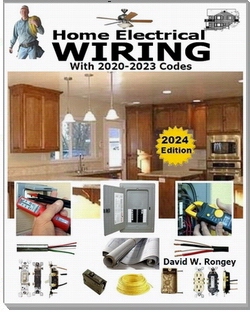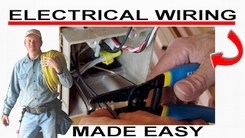» Home Electrical Wiring
» Electrical Wiring Directory
» Electrician Training
» Need Electrical Help? Ask the Electrician
» Electrician Training
» Need Electrical Help? Ask the Electrician
Electrical Contractors License
and Electrical Apprenticeship Programs

|
Summary: The advantages of an Electrician Apprenticeship program and how to become a Licensed Electrical Contractor.
© By: Dave Rongey |
The Electrical Apprenticeship and how it can Work for You
Why choose Electrician Apprenticeship?
Apprenticeship means real skills and real careers.
Electrician Apprenticeship Proven Success
Today’s electricians were yesterday’s apprentices, in most cases. Electrician Apprenticeship Proven Methods. You will be taught by experienced professionals and take approximately 144 hours of related classes each year and you'll have a chance to practice your new electrical skills on the job while you are learning.
Consider the Higher Electrician Wages
Skilled electricians pay more than unskilled. That’s why apprenticeships typically lead to higher wages plus great benefits.
How to Become an Apprentice Electrician |
|
 |
Dave Rongey Recommends California Electrical Contractors License California Electrical Contractors License |
Positions for Electrical Workers |
|
| ACCESS CONTROL ELECTRONICS TECHNICIAN APPLIANCE SERVICEMAN CABLE SPLICER CONSTRUCTION AND INDUSTRIAL ELECTRICIAN ELECTRIC UTILITY TECHNICIAN ELECTRICAL ESTIMATOR ELECTRICAL/ELECTRONIC MAINTAINER ELECTRICIAN CONSTRUCTOR ELECTRONICS TECHNICIAN HYDRO ELECTRICIAN INDUSTRIAL ELECTRONIC MAINTENANCE TECHNICIAN INDUSTRIAL MAINTENANCE ELECTRICIAN INDUSTRIAL MAINTENANCE ELECTRICIAN/ELECTRONICS INDUSTRIAL SUBSTATION ELECTRICIAN LIMITED RESIDENTIAL ELECTRICIAN LOW ENERGY/SOUND AND COMMUNICATION TECHNICIAN |
MAINTENANCE ELECTRICIAN MAINTENANCE ELECTRICIAN/ELECTRONICS MARINE ELECTRICIAN METER ELECTRICIAN MOTOR SHOP ELECTRICIAN NEON AND ELECTRICAL SIGN ELECTRICIAN OIL BURNER ELECTRICIAN QUALITY CONTROL APPRENTICES RADIO TELEVISION ELECTRICAN RESIDENTIAL ELECTRICIAN SHOP ELECTRICIAN SIGNAL - LIGHTING ELECTRICIAN SOUND COMMUNICATION AND ELECTRONIC CONTROL STATION ELECTRICIAN/WIREMAN/POWER SUPPLY ELECTRICIAN WIRE ELECTRICIAN |
|
Types of Electrical Work Construction and residential electricians work in all phases of the electrical construction and service industry. They do the electrical construction work on projects ranging from single-family residences to state-of-the-art industrial plants. Workers install conduits and wire all lighting, along with switches and converters, to complex systems incorporating computerization and high technology in the installation and maintenance of electrical systems. Their work includes both small and large commercial installation up to and including high-rise buildings. Electricians also do repair and maintenance on all electrical installations. The low voltage/sound and communication apprenticeship includes work processes in fiber optics, telephone systems, sound and fire alarm systems, LAN and structured wiring systems. |
| Examples of Working Conditions as an Electrician This work is done in the full range of environmental conditions to include outside in the dirt, cold, sun, rain, and snow; inside in climate-controlled modern offices, and in state-of-the-art clean rooms in hospitals and manufacturing plants. The work can require considerable standing, bending and reaching and may be conducted in cramped spaces or at great heights. The Electrician Apprenticeship The program, depending upon your area, consists of 2,000-10,000 hours on-the-job training. Additionally, 144-216 hours of classroom instruction is required per year. Generally the additional training is conducted two nights per week. Electrician Apprenticeship Entry Requirements (Requirements vary slightly in different regions)
|
| The Division of Apprenticeship Standards states that
Electrician Certification may be required in your area. Contact your local apprenticeship office for more details. * These figures may change depending on your location and position. |
How To Get Training About Home Electrical WiringQuestion: How can I get to know more training about house electrical wiring? I am in my high school now offering electrical as my course and I will to get more in order to avoid bad work. I need your help about that please. Answer: Seek an electrical contractor in your area who will allow you to work as a helper where you will gain on the job observation and experience. I personally feel that there will be a great deal of home remodeling work in the near future, especially as new energy efficient devices come to the market and we see more electric cars come on the market. So I would encourage you to begin your education about home electrical wiring and keep an eye on all the new technologies that are coming out. |
The Safest Way to Test Electrical Devices and Identify Electric Wires!The Non-Contact Electrical TesterThis is a testing tool that I have had in my personal electrical tool pouch for years, and is the first test tool I grab to help identify electrical wiring. It is a Non-contact tester that I use to easily Detect Voltage in Cables, Cords, Circuit Breakers, Lighting Fixtures, Switches, Outlets and Wires. Simply insert the end of the tester into an outlet, lamp socket, or hold the end of the tester against the wire you wish to test. Very handy and easy to use.
The Quickest Way to Check for Faulty Electrical Wiring!The Plug-In Outlet TesterThis is the first tool I grab to troubleshoot a problem with outlet circuit wiring. This popular tester is also used by most inspectors to test for power and check the polarity of circuit wiring. It detects probable improper wiring conditions in standard 110-125 VAC outlets Provides 6 probable wiring conditions that are quick and easy to read for ultimate efficiency Lights indicate if wiring is correct and indicator light chart is included Tests standard 3-wire outlets UL Listed Light indicates if wiring is incorrect Very handy and easy to use.
Strip Off Wire Insulation without Nicking and Damaging the Electric Wire!The Wire Stripper and Wire CutterMy absolute favorite wire stripping tool that I have had in my personal electrical tool pouch for years, and this is the tool I use to safely strip electrical wires. This handy tool has multiple uses: The wire gauges are shown on the side of the tool so you know which slot to use for stripping insulation. The end of the tool can be used to grip and bend wire which is handy for attaching wire onto the screw terminals of switches and outlets.. The wire stripper will work on both solid and stranded wire. This tool is Very Handy and Easy to Use. |
||
Residential Electrical Parts and AccessoriesLight Switches 120volt Outlets Circuit Breakers Electrician Tools Voltage Testers |














